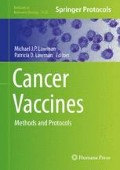Abstract
Major histocompatibility complex (MHC) Class II-positive, invariant chain (Ii)-suppressed tumor cells induce both T helper and cytotoxic T lymphocytes’ responses. Genetically controlled immunotherapy could be utilized for prophylactic vaccination of tumor-free individuals who are at high risk of developing tumor and can be therapeutic for treating established tumors that are nonresponsive to existing therapies. In this chapter, we provide practical methods to create a potent in vivo tumor cell vaccine by inducing MHC Class II and Ii using MHC Class II transactivator (CIITA) or interferon-gamma (IFN-γ) and subsequently inhibiting Ii by antisense oligonucleotides. We also describe the development of an adenoviral vector.
Access this chapter
Tax calculation will be finalised at checkout
Purchases are for personal use only
References
Restifo NP et al (1993) Molecular mechanisms used by tumors to escape immune recognition: immunogenetherapy and the cell biology of major histocompatibility complex class I. J Immunother 14:182–190
Costello RT et al (1999) Tumor escape from immune surveillance. Arch Immunol Ther Exp (Warsz) 47:83–88
Garcia-Lora A et al (2003) Tumour immunology, vaccination and escape strategies. Eur J Immunogenet 30:177–183
Humphreys RE et al (2004) Forcing tumor cells to present their own tumor antigens to the immune system: a necessary design for an efficient tumor immunotherapy. Cell Mol Immunol 1(3):180–185
Hillman GG et al (2004) Turning tumor cells in situ into T-helper cell-stimulating, MHC Class II tumor epitope-presenters: immuno-curing and immuno-consolidation. Cancer Treat Rev 30(3):281–290
Marsman M et al (2005) Chaperoning antigen presentation by MHC Class II molecules and their role in oncogenesis. Adv Cancer Res 93:129–158
Castellino F et al (1997) Antigen presentation by MHC class II molecules: invariant chain function, protein trafficking, and the molecular basis of diverse determinant capture. Hum Immunol 54(2):159–169
Bertolino P, Rabourdin-Combe C (1996) The MHC Class II-associated invariant chain: a molecule with multiple roles in MHC class II biosynthesis and antigen presentation to CD4+ T cells. Crit Rev Immunol 16:359–379
Kropshofer H et al (1996) Editing of the HLA-DR-peptide repertoire by HLA-DM. EMBO J 15:6144–6154
Xu M et al (2000) Genetic modulation of tumor antigen presentation. Trends Biotechnol 18:167–172
Spiro RC et al (1984) The Ii nature of p35 on hairy leukemic cells. Semin Oncol 11:427–432
Baskar S et al (1994) MHC class II-transfected tumor cells induce long-term tumor-specific immunity in autologous mice. Cell Immunol 155:123–133
Scanlon KJ et al (1995) Oligonucleotide-mediated modulation of mammalian gene expression. FASEB J 9:1288–1296
Dias N, Stein CA (2002) Antisense oligonucleotides: basic concepts and mechanisms. Mol Cancer Ther 1(5):347–355
Qiu G et al (1999) Cancer immunotherapy by antisense suppression of Ii protein in MHC-class-II-positive tumor cells. Cancer Immunol Immunother 48(9):499–506
Lu X et al (2003) Tumor immunotherapy by converting tumor cells to MHC class II-positive, Ii protein-negative phenotype. Cancer Immunol Immunother 52(10):592–598
Hillman GG et al (2003) Generating MHC Class II+/Ii− phenotype after adenoviral delivery of both an expressible gene for MHC Class II inducer and an antisense Ii-RNA construct in tumor cells. Gene Ther 10(17):1512–1518
Author information
Authors and Affiliations
Editor information
Editors and Affiliations
Rights and permissions
Copyright information
© 2014 Springer Science+Business Media New York
About this protocol
Cite this protocol
Akl, M.R., Ayoub, N.M. (2014). Tumor Cell Transformation Using Antisense Oligonucleotide. In: Lawman, M., Lawman, P. (eds) Cancer Vaccines. Methods in Molecular Biology, vol 1139. Humana Press, New York, NY. https://doi.org/10.1007/978-1-4939-0345-0_22
Download citation
DOI: https://doi.org/10.1007/978-1-4939-0345-0_22
Published:
Publisher Name: Humana Press, New York, NY
Print ISBN: 978-1-4939-0344-3
Online ISBN: 978-1-4939-0345-0
eBook Packages: Springer Protocols

